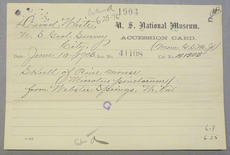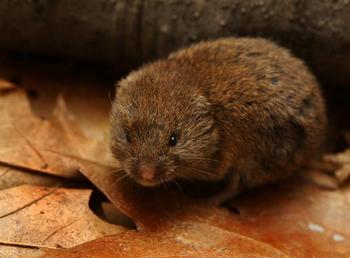As a summer pre-program conservation intern with the Smithsonian Center for Archives Conservation, I have had the opportunity to work with a variety of book and paper objects. The Center for Archives Conservation is a treatment laboratory located at the Smithsonian Institution Archives that provides conservation services for the Archives' permanent collections, as well as for sister archives and special collections within the Smithsonian community. Primarily I work on field book paper objects from the National Museum of Natural History (NMNH), but sometimes I get to branch out and work on objects from the Archives' collections.

Most recently, I've been working on Record Unit 305, which contains the US National Museum, Office of the Registrar, Accession Records, 1834-1958. In 1881, the first US National Museum building, now the Smithsonian's Arts and Industries Building, opened to house art, cultural, history, and science exhibits. These accession records constitute the official documentation of the national collections and include correspondence with donors, specimen lists, and subsequent correspondence documenting the history of the collections. The richness and breadth of these collections at the Archives is astounding, and the documentation of these objects and how they came to
be collected is equally vast. Care for it has included tear mends, flattening, tape removal, and cleaning. It has been a great way for the other summer conservation intern, Janelle (who you will hear from later this month), and me to learn the core skills of paper conservation. Part of the fun in conserving and rehousing this collection is reading all the different things the Smithsonian accessioned in its early years. I would like to share with you an interesting accession file found within Record Unit 305.
The skull of one pine mouse (Microtus pinetorum—which is actually a Woodland or Pine Vole) was given to the museum by David White from Webster Springs, West Virginia. In June of 1903, White conducted a US geological survey in the area of Elk Mountain and happened upon an "unusual situation." As described in a letter found in the accession file, he found the mouse 3 1/4 inches apart and nose to nose with a rattlesnake. After hitting the snake soundly in the head with a rock, White picked up the mouse and ascertained that it was still alive, though sluggish and with no bite marks or disturbances present in its fur. He placed the mouse in his pocket and continued about his survey. At the end of the day, White found the mouse was dead. Aided by the sketch included in his letter, White felt "the circumstances all strongly suggest hypnotism . . . " by the snake. The mouse was given to the museum for examination to determine if this cause of death was accurate.
On January 22, 1907 the Smithsonian drafted a reply to White. They offered that there was no reason to dissect the mouse to ascertain the cause of death nor would they like to express as opinion, but ultimately "Mr. White’s guess seems to be as good as any under the circumstances."
Needless to say, I have been sharing this great little story with the rest of the Archives. Most enjoy the fact that the object has a great accession story and it has prompted many to make their own hypotheses as to the cause of death. Some say the mouse was "scared to death by the snake," while others express disbelief, and claim it was injured and killed in White's pocket. What do you think happened? Sound off in the comments below!
Related Resources
- United States National Museum online exhibition, Smithsonian Institution Archives
- Arts and Industries Building, Smithsonian Institution Archives
- Smithsonian Center for Archives Conservation, Smithsonian Institution Archives
Produced by the Smithsonian Institution Archives. For copyright questions, please see the Terms of Use.


Leave a Comment